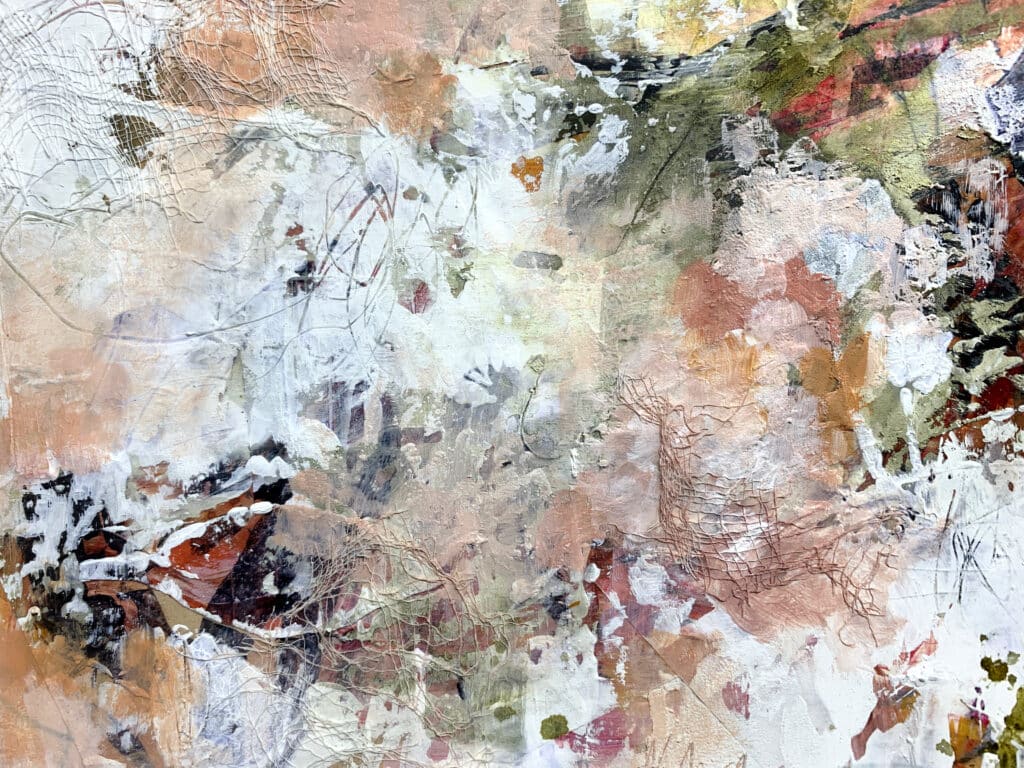Layer 1: Establishing the Foundation – Scribble & Journal
- Scribble with a Pencil
- Process: With your eyes closed, scribble freely across the surface, focusing on the feeling of your hand moving.
- Pointer: Let go of control and allow your energy to flow through the pencil. These marks are raw expressions of emotion.
- Blend with Gesso
- Process: Use a palette knife to spread gesso over parts of the scribbled lines, blending some areas and leaving others exposed.
- Pointer: Play with texture here, creating areas of softness and thickness. This sets up the groundwork for contrast later.
Layer 2: Adding Collage Elements
- Collage with Vintage Paper
- Process: Tear small pieces of neutral or vintage-colored paper, using gel medium to adhere them onto the surface.
- Pointer: Let the organic edges of the paper guide you. Place the pieces where they create interest without overthinking the layout.
Layer 3: Adding Boldness and Contrast
- Bold Strokes of Dark Paint
- Process: With a large flat brush, make bold, broad strokes using dark paint (like black or Payne’s grey).
- Pointer: Embrace the intensity of these marks. This is where contrast and strength come into play.
- Fine Details with a Small Brush
- Process: Switch to a smaller brush to create delicate lines and marks.
- Pointer: Feel the balance between strong and subtle—every emotion and mark has a place here.
Layer 4: Experiment with Acrylic Colors & Layers
- Layering with Acrylic Paint
- Process: Choose 2-3 colors and layer acrylic paint using both brushes and knives. Let some collage elements peek through.
- Pointer: This is the chaotic layer—don’t shy away from overlapping colors. Let the unexpected interactions guide you.
Layer 5: Building Texture with Paste
- Add Texture Paste
- Process: Scrape texture paste or thick gesso across the surface with a palette knife. Scratch into the wet paste to reveal earlier layers.
- Pointer: Build up the surface here, creating dimension. Some previous marks will be covered, but new textures emerge.
Layer 6: Experimenting with Tools
- Add Marks with Stencils & Tools
- Process: Experiment with stencils, ghost prints, and different tools. Scribble more with a pencil, blending into the textured areas.
- Pointer: Each tool has its own voice—layer them together to build complexity and intrigue.
Layer 7: Adding Lightness with White
- Cover with White Paint
- Process: Spread white paint over areas that feel too heavy or chaotic using a palette knife or wedge.
- Pointer: White brings clarity and space. Let it edit the chaos while allowing the previous layers to peek through.
Layer 8: Pops of Color
- Add Contrasting Color
- Process: Use a smaller brush to add pops of contrasting color across the surface.
- Pointer: This final color should breathe life into the quieter areas. Use it sparingly for the most impact.
Layer 9: Fabric Collage
- Integrate Fabric Elements
- Process: Adhere pieces of gauze, cheesecloth, or netting to the surface using matte gel medium. Once dry, lightly paint over or around the fabric.
- Pointer: The fabric adds tactile interest—let it break the flatness and create a new layer of depth.
By following these steps, you build up a dynamic composition, layer by layer, allowing for both intentional marks and spontaneous exploration.




